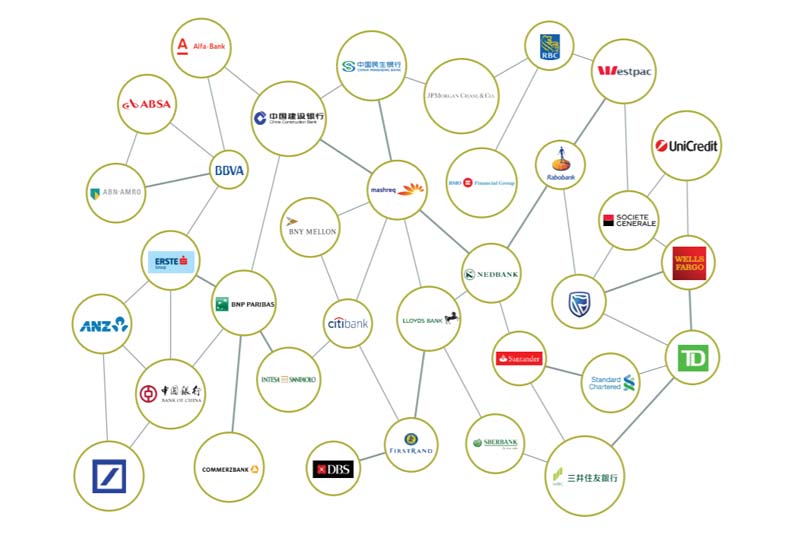
Earlier this month, SWIFT (Society for Worldwide Interbank Financial Telecommunication) published
the final results from its DLT (Distributed Ledger Technology or blockchain) proof
of concept for Nostro reconciliation.
Under the current correspondent banking model, a
correspondent bank provides services on behalf of another overseas financial
institution through a correspondent account (Nostro/ Vostro accounts).
Correspondent accounts are established through bilateral agreements between the
two banks.
According to a 2016 McKinsey report, on an average, 34% of
the cost of an international payment is related to Nostro trapped liquidity
caused by the absence of real-time data to optimise intraday liquity
management. Around 9% of the cost is linked to investigations or exceptions
mainly driven by a lack of standardisation in the end-to-end payment’s process,
and by the related Nostro account reconciliation.
SWIFT’s DLT POC, which started in
April 2017, sought
to test whether DLT can help banks reconcile Nostro accounts more
efficiently and in real-time, while lowering costs and operational risk. Preliminary
results were published
in October 2017.
Participation from 34
banks
A total of 34 banks contributed to the proof of concept. They
were segmented in two groups working independently from each other. The initial
six financial institutions in the founding group worked with SWIFT to explore
and define the standards, data model, business and functional specifications,
that resulted in the creation of the concept model. They tested the application
and provided a number of change requests to improve the user’s experience of
the application, of which, a certain number were implemented prior to the start
of the final phase of testing with the validation group in September 2017.
The validation group of 28 financial institutions were
tasked with executing the same set of tests to provide independent conclusions
on the enhanced solution
The initiative was one of the most extensive blockchain
proofs of concept powered by Hyperledger Fabric 1.0 (Hyperledger is a global open
source collaborative effort created to advance cross-industry blockchain
technologies, hosted by The
Linux Foundation) executed in the industry till date, both in terms of
participant engagement and in terms of the scale of the infrastructure
deployed.
With the PoC SWIFT set out to work with the technology in a
“many-to-many” setting addressing a real business issue, and draw lessons for
larger scale implementations of the technology in the bank-to-bank payment
area. The PoC sought to assess whether DLT, combined with SWIFT assets, would
meet industry-level governance, security and data privacy requirements, whether
DLT could bring concrete benefits over other architectures, and to check DLT’s
current level of maturity to serve as a production-grade application within a
mission-critical global infrastructure.
Based on the business and technical requirements validated
by the participating banks, SWIFT developed a DLT solution through which Nostro
Account owners and their servicers could share a private confidential ledger
recording transactions related to their Nostro accounts.
The solution leverages ISO 20022 standards
and gpi
innovations – including the unique end-to-end transaction reference (UETR) –
and integrates intraday liquidity standards. The PoC was built within the SWIFT
DLT sandbox environment – a use case agnostic DLT platform which enables
experimentation and collaboration between SWIFT and its community.
The PoC showed that DLT could deliver the business
functionalities and data richness required to support automated real-time
liquidity monitoring and reconciliation. It enabled real-time event handling,
transaction status updates, full audit trails, visibility of expected and
available balances, real-time simplified account entries confirmation, the
identification of pending entries and potential related issues, and generated
the data required to support regulatory reporting.
The PoC also demonstrated the significant progress DLT has
made with regards to data confidentiality, governance, security, and
identification frameworks, showing that that the emergent technology, combined
with SWIFT assets, provides the necessary foundation for financial multi-bank
applications.
“The PoC went extremely well, proving the fantastic progress
that has been made with DLT and the Hyperledger Fabric 1.0 in particular”, said
Damien Vanderveken, Head of Research and Development at SWIFT. “The DLT sandbox
enabled us to control access, to define and enforce user privileges, to
physically segregate confidential data and store it only with the relevant
parties while supporting a strong identity framework by linking all
participants to their BIC, and having all keys signed by a SWIFT certification
authority”.
Pre-requisites for
industry adoption
However, the PoC also found that there are considerable
pre-requisites for industry adoption of such a solution. For instance, all
account servicers would first need to migrate from batch to real-time liquidity
reporting and processing. Today, 44% of cross border payments exchanged over
SWIFT generate a real-time confirmation of debit or credit.
While the DLT application could provide a platform to share
the information, significant work and investment would be required to upgrade banks’
back-office applications so that they can feed the platform with real-time
updates. The success of any solution will therefore depend upon deep
integration with back office systems using APIs. These implementation costs could
be significantly lowered should ISO 20022 standards be adopted first.
In addition, a value proposition for each market segment
catering for different levels of sophistication, automation of operations and
past investments would be key to ensure industry-wide adoption and coexistence.
For instance, the benefits of DLT for the larger clearing
banks are less clear since their dependency on external Nostro Servicer
providers is reduced overall when compared to mid-tier banks. Larger banks
typically manage their key currencies internally and have already invested
heavily in highly optimised liquidity and reconciliation tools.
To facilitate improvements in the Nostro process, SWIFT will
continue helping its community migrate towards real-time liquidity reporting
and processing through SWIFT gpi, and establish a roll-out plan for the
community-wide adoption of the UETR.
SWIFT will also initiate an ISO 20022 consultation with its
community to assess a timeline and a migration approach towards ISO 20022 as a
potential means to reduce integration costs, and will continue to actively
promote the re-use of ISO 20022 in the DLT context.
The PoC also showed that further progress is needed on the
DLT technology itself, before it will be ready to support production-grade
applications in large-scale, mission-critical global infrastructures.
For example, while 528 channels were required in the PoC to
ensure Nostro accounts would only be stored on the nodes of their account
servicers and owners, to productise the solution, more than 100,000 channels
would need to be established and maintained, covering all existing Nostro
relationships, presenting significant operational challenges.
Stephen Gilderdale, Chief Platform Officer, SWIFT, said, “It
is a strategic priority for SWIFT to work with new technologies like DLT and
incorporate them into key solutions like gpi. We are already working on new
PoCs and will continue our R&D efforts to ensure that SWIFT customers will
be able to leverage their existing SWIFT infrastructure and connectivity to
benefit from blockchain services, whether offered by SWIFT or by third parties,
on a secure and trusted platform.”
















